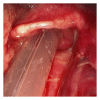A rare complication of tracheal intubation: tongue perforation
- PMID: 23056962
- PMCID: PMC3465871
- DOI: 10.1155/2012/281791
A rare complication of tracheal intubation: tongue perforation
Abstract
Aim. To describe the subsequent treatment of airway trauma sustained during laryngoscopy and endotracheal intubation. Methods. A rare injury occurring during laryngoscopy and endotracheal intubation that resulted in perforation of the tongue by an endotracheal tube and the subsequent management of this unusual complication are discussed. A 65-year-old female with intraparenchymal brain hemorrhage with rapidly progressive neurologic deterioration had the airway secured prior to arrival at the referral institution. The endotracheal tube (ETT) was noted to have pierced through the base of the tongue and entered the trachea, and the patient underwent operative laryngoscopy to inspect the injury and the ETT was replaced by tracheostomy. Results. Laryngoscopy demonstrated the ETT to perforate the base of the tongue. The airway was secured with tracheostomy and the ETT was removed. Conclusions. A wide variety of complications resulting from direct and video-assisted laryngoscopy and tracheal intubation have been reported. Direct perforation of the tongue with an ETT and ability to ventilate and oxygenate subsequently is a rare injury.
Figures
References
-
- Martin LD, Mhyre JM, Shanks AM, Tremper KK, Kheterpal S. 3,423 emergency tracheal intubations at a university hospital: airway outcomes and complications. Anesthesiology. 2011;114(1):42–48. - PubMed
-
- Aziz MF, Healy D, Kheterpal S, Fu RF, Dillman D, Brambrink AM. Routine clinical practice effectiveness of the glidescope in difficult airway management: an analysis of 2,004 glidescope intubations, complications, and failures from two institutions. Anesthesiology. 2011;114(1):34–41. - PubMed
-
- Cooper RM. Complications associated with the use of the GlideScope videolaryngoscope. Canadian Journal of Anesthesia. 2007;54(1):54–57. - PubMed
-
- Bartlett DS, Grace R, Newell S. Perforation of and intubation through the palatoglossal fold. Anaesthesia and Intensive Care. 2009;37(3):481–483. - PubMed
-
- Sejwal S, Tandon M, Ganjoo P, Sharma A. Pneumomediastinum due to hypopharyngeal injury during orotracheal intubation. Canadian Journal of Anesthesia. 2007;54(9):p. 767. - PubMed
LinkOut - more resources
Full Text Sources






